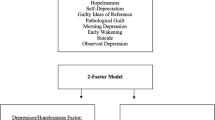Abstract
Background
The comorbidity bias predicts that if disease definition is based on observations of patients in the hospital, spurious comorbidity of psychopathological dimensions that increase the probability of hospital admission will be included in the disease concept, whereas comorbid dimensions that are not associated with admission will be excluded. The direction of any dimensional comorbidity bias in psychotic illness was assessed in a longitudinal analysis of the psychopathology of patients assessed both inside and outside the hospital.
Method
Four hundred and eighty patients with broadly defined psychotic disorders were assessed between one and nine times (median two times) over a 5-year period with, amongst others, the Brief Psychiatric Rating Scale. Dimensional comorbidities between positive symptoms, negative symptoms, depression/anxiety, and manic excitement were compared, in addition to their associations with current and future admission status.
Results
Higher levels of psychopathology in all symptom domains were associated with both current and future hospital admissions. Associations between the positive, negative, and manic symptom domains were higher for patients in the hospital than for patients outside the hospital, in particular, between positive symptoms and manic excitement (β=0.28, p<0.001). However, associations between depression and other symptom domains were higher in out-patients as compared to in-patients (positive symptoms and depression, β=−0.26; p<0.002).
Conclusion
The current analyses suggest that, to the extent that disease concepts of psychosis do not take into account effects of dimensional comorbidity biases occasioned by differential psychopathology according to treatment setting, “florid” psychotic psychopathology may be overrepresented, whereas depressive symptoms may be spuriously excluded.
Similar content being viewed by others
References
Berkson J (1950) Are there two regressions? J Am Stat Assoc 45:164–180
Maric N, Myin-Germeys I, Delespaul P, de Graaf R, Vollebergh W, Van Os J (2004) Is our concept of schizophrenia influenced by Berkson's bias? Soc Psychiatry Psychiatr Epidemiol 39:600–605
van Os J, Hanssen M, Bijl RV, Ravelli A (2000) Strauss (1969) revisited: a psychosis continuum in the general population? Schizophr Res 45:11–20
van Os J, Hanssen M, Bijl RV, Vollebergh W (2001) Prevalence of psychotic disorder and community level of psychotic symptoms: an urban–rural comparison. Arch Gen Psychiatry 58:663–668
Verdoux H, van Os J (2002) Psychotic symptoms in non-clinical populations and the continuum of psychosis. Schizophr Res 54:59–65
Jablensky A, Kendell RE (2002) Criteria for assessing a classification in psychiatry. In: Mai M, Gaebel W, López-Ibor JJ, Sartorius N (eds) Psychiatry diagnosis and classification. Wiley, Chichester, pp 1–24
Ustun TB, Chatterji S, Andrews G (2002) International classifications and the diagnosis of mental disorders: strengths, limitations and future perspectives. In: Mai M, Gaebel W, López-Ibor JJ, Sartorius N (eds) Psychiatric diagnosis and classification. Wiley, Chichester, pp 25–46
Carr VJ, Lewin TJ, Barnard RE, Walton JM, Allen JL, Constable PM, Chapman JL (2002) Comparisons between schizophrenia patients recruited from Australian general practices and public mental health services. Acta Psychiatr Scand 105:346–355
Castle DJ, Phelan M, Wessely S, Murray RM (1994) Which patients with non-affective functional psychosis are not admitted at first psychiatric contact? Br J Psychiatry 165:101–106
Delespaul P, Bak M, Van Os J (2002) Handleiding Maastrichtse Psychoseprotocol. Maastricht University, Maastricht
American Psychiatric Association A (1994) DSM-IV: diagnostic and statistical manual of mental disorders. APA, Washington, D.C.
Overall JE, Gorham D (1962) The Brief Psychiatric Rating Scale. Psychol Rep 10:799–812
Ventura J, Green MF, Shaner A, Liberman RP (1993) Training and quality assurance with the Brief Psychiatric Rating Scale: “the drift Busters”. Int J Methods Psychiatr Res 3:221–244
Slade M, Phelan M, Thornicroft G, Parkman S (1996) The Camberwell Assessment of Need (CAN): comparison of assessments by staff and patients of the needs of the severely mentally ill. Soc Psychiatry Psychiatr Epidemiol 31:109–113
Ventura J, Nuechterlein KH, Subotnik KL, Gutkind D, Gilbert EA (2000) Symptom dimensions in recent-onset schizophrenia and mania: a principal components analysis of the 24-item Brief Psychiatric Rating Scale. Psychiatry Res 97:129–135
StataCorp (2002) STATA. College Station, Texas
Everitt BS (1995) Statistical design, analysis and correspondence. Br J Psychiatry 166:540
Ochoa S, Haro JM, Usall J, Autonell J, Vicens E, Asensio F (2005) Needs and its relation to symptom dimensions in a sample of outpatients with schizophrenia. Schizophr Res 75:129–134
Carr V, Halpin S, Lau N, O'Brien S, Beckmann J, Lewin T (2000) A risk factor screening and assessment protocol for schizophrenia and related psychosis. Aust N Z J Psychiatry 34(Suppl):S170–S180
Garety PA, Kuipers E, Fowler D, Freeman D, Bebbington PE (2001) A cognitive model of the positive symptoms of psychosis. Psychol Med 31:189–195
McGlashan TH (2000) Treating schizophrenia earlier in life and the potential for prevention. Curr Psychiatry Rep 2:386–392
McGorry P (2001) Rationale for and the substantial potential benefits linked to early recognition and optimal treatment of psychotic disorders, specifically schizophrenia. Acta Psychiatr Scand 103:402–403
Acknowledgements
We thank all the participants for their contribution to the CNCR data collection.
Author information
Authors and Affiliations
Corresponding author
Additional information
Bak and Drukker shared first authorship
Rights and permissions
About this article
Cite this article
Bak, M., Drukker, M., van Os, J. et al. Hospital comorbidity bias and the concept of schizophrenia. Soc Psychiat Epidemiol 40, 817–821 (2005). https://doi.org/10.1007/s00127-005-0971-0
Accepted:
Published:
Issue Date:
DOI: https://doi.org/10.1007/s00127-005-0971-0




